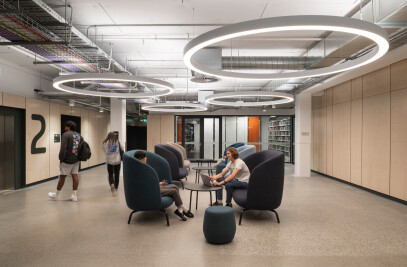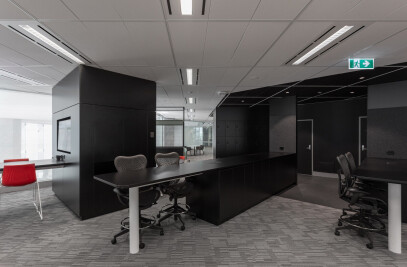The aspiration behind the major refurbishment of the J Robin Warren Library at the University of Western Australia was to transform the existing Medical and Dental Library into a modern student-centric education and learning facility.
Engaging closely with students, library staff and faculty throughout the process, the design team at Hames Sharley developed underlying concepts that draw upon recognisable iconography from within the student’s fields of study, by connecting a contemporary, sophisticated interior with elements influenced by vintage medical diagrams, dental x-rays, and medical equipment materiality. The resulting technology-rich library is tailored to meet the changing working styles of today, and has high quality learning and study spaces that create a modern, vibrant and dynamic hub of knowledge, support and collaboration for graduates and the community. Subtle references can be spotted such as seating and desk arrangements reflecting rows of teeth. Each of the three floors has a distinct purpose. The ground floor is open to the public and provides a collaborative working hub with a 120-seat e-learning suite suitable for large-to-small group teaching and a bookable 60-seat seminar room. The spaces are technology enabled and can be easily configured as study spaces when not in use for classes or events. There are also small study booths, a student lounge and kitchen facilities.
The library also features an Alumni Lounge which offers exclusive work and meeting space for graduates, donors and community partners, honouring their important role in world-class teaching, research and practice.
The first floor is designed for individual learning and focus. There is a 20-seat technology-enabled training facility, a range of group study booths and a number of single desks, each with power and IT access, including ample space for laptops, notebooks and books. The book collection remains, although much reduced in size, and librarians are on hand to assist and provide access to high demand and high use collections.
Level Two accommodates the Faculty in a contemporary flexible workplace with boardroom and new amenities. A neutral palette with elements of light timber reflects the building’s exterior and colours inspired by antique anatomy illustrations lift the main palette by adding warmth and vibrancy. Skeletal illustrations inspired the feature ceiling and dentition influenced the design of the central collaborative table, which twists through the core area of the Ground Level. This enhances the space by introducing a new circulatory movement, and promotes collaboration and connectivity. Throughout the design process an awareness of the building’s functional performance was of paramount importance. Multi-use spaces that could be repurposed for different user groups were included and facilitated through the inclusion of sliding glass walls which give spaces differing aspects and dimensions depending on the user’s specific requirements.
Hames Sharley provided leadership and Interior Architecture services, with specialist sub-consultants and university staff forming a cohesive team. Books have been replaced by people, and without increasing energy use the number of occupants has increased from 296 to 401.
SUSTAINABILITY
- A sustainable design approach was taken in every aspect of the refurbishment of the J Robin Warren Library at the University of Western Australia.
- Environmental principles of design where incorporated throughout the process and where possible a minimalist, locally sourced approach was adopted in the selection of fixtures and materials.
- Various elements within the building were recycled or repurposed during the refurbishment, including the librarian trolleys which are now discreetly hidden behind new facades.
- To maximize the conservation of energy natural light was amplified with the inclusion of glass walls, and ventilation was increased to allow air to flow throughout the space.
- The project also had a focus on maximizing the building’s use by students, academics and alumni throughout the day and night. The key principle in achieving this was through carefully considered lighting that creates a warm and welcoming environment in which users could feel safe at all times.

































